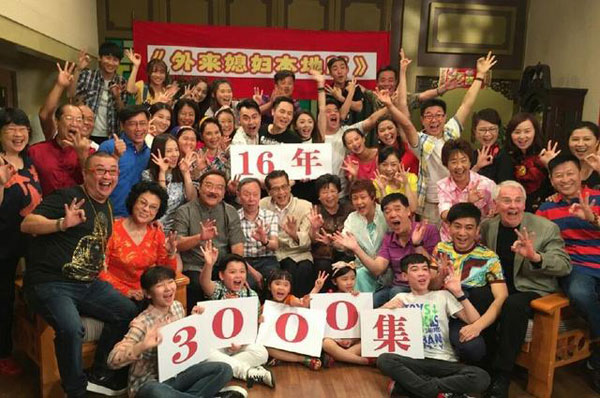'In-Laws, Out-Laws': the people's story
china.org.cn / chinagate.cn by Wei Jia, February 21, 2017 Adjust font size:
Since its debut in 2000, the sitcom "In-Laws, Out-Laws" has been telling the fictional story of a family in Guangdong. It has more than 3,100 episodes, more than any other TV series in the country. The TV evergreen owes its success to staying true to real life and keeping its finger on the pulse of the audience.
|
A photo of the "In-Laws, Out-Laws" cast. [Photo/Xinhua] |
Local TV stations in Guangdong and the Pearl River Delta were also-rans in the 80s when Hong Kong TV dominated audience ratings there.
Guangdong Television tasked Lu Xiaoguang with getting local TV series back in the game. TV series made in the Chinese mainland at the time didn't care much about audience reaction, so the station gave Lu a specific order to make "something for the people, not to win awards."
After learning from his counterparts in Hong Kong, Lu co-created The Kaleidoscope, a TV series based on the everyday lives of ordinary Guangdong locals. It was a hit and convinced Lu where the way forward was.
As the bastion of China's opening up, Guangdong attracted aspiring Chinese from all around the country. This influx of people meant different cultures and ways of life sometimes conflicted in the fast changing city. There couldn't have been a better inspiration for Lu, who captured the social dynamic in the life of a family with four sons in Guangdong's old district.
Each son married a girl from out of town. The ensuing friction between different lifestyles has served as the main comedic premise, drawing laughs from the show's loyal audience, mostly from south China, for decades.
The show is not just about fun. Lu and his team made sure their story was as authentic as possible, creating characters as flawed as any real person. And their lives onscreen were not much different from those of regular people in Guangdong. The ups and downs in these characters' lives resonated with the viewer.
During the show's heyday in 2003 and 2004, five channels of the Pearl River TV station were airing the show. An interminable 37 commercials played between two episodes, each of which was just over 20 minutes long. "The viewers probably forgot what the last episode was about after the commercial break," joked Lu.
Since 2000, "In-Laws, Out-Laws" has helped Guangdong Television station attract more than 2 billion yuan ($290 million) in advertising.
With the theme of family threading through all its episodes, the best evidence of the show's success is not on the balance sheet.
One day in 2003, the actors were in a bind and needed somewhere off-set to change and do make-up. They knocked on the door of a house by the Pearl River. The owner, an old man, invited them in. On the wall, where a family picture should be, was a group picture of the "In-Laws, Out-Laws" cast. The man was a widower for several years and all his children had moved away. The show's drama, he said, filled some of the voids in his life.
Now, the popularity of web series and audience fatigue after following the same characters for 16 years has put a question mark over the show's future. In a recent interview, Lu said the show would go on, and he is considering a younger person to take over the helm.
